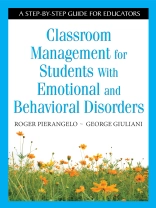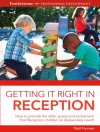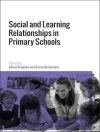‘General education teachers need more information and guidance on how to effectively work with students with emotional and behavioral disorders. This book provides an overview of the various needs and characteristics that many of these students display.’
—Emily Wilmes, Emotional Behavioral Disorder Teacher
Roosevelt Elementary School, Mankato, MN
Effective methods for teaching students with emotional and behavioral disorders!
Written by experts in the field of special education, this guide provides a clear and comprehensive overview of emotional and behavioral disorders (EBD), along with practical guidelines for working with students diagnosed with EBD.
Aligned with the reauthorization of IDEA 2004, these effective and culturally sensitive techniques help teachers understand and distinguish typical behavior from the symptoms, problems, and characteristics of EBD, such as moodiness, argumentative behavior, anger, difficulty interacting with peers, refusing to share, and inability or unwillingness to take responsibility.
Ideal for general and special education teachers, this step-by-step resource includes references, a glossary, and information about:
- Positive reinforcements and effective instructional interventions for the classroom
- Federal regulations related to students with EBD
- Ways to promote healthy social interactions
- Classroom management strategies for specific disorders
Classroom Management for Students With Emotional and Behavioral Disorders provides invaluable guidance for redirecting students toward more appropriate behaviors, building important social skills, and establishing a positive classroom climate for all learners.
Mục lục
Dedications
About the Authors
Preface
1. Review Your Knowledge on Students With Emotional and Behavioral Disorders
Definition of Emotional Disturbance
Causes of Emotional and Behavioral Disorders
Prevalence of Emotional Disturbance
Age of Onset of Emotional and Behavioral Disorders
Gender Features of Emotional and Behavioral Disorders
Cultural Features of Emotional and Behavioral Disorders
Eligibility Criteria for Emotional Disturbance Under IDEA
Characteristics of Students With Emotional Disturbance
Children With Emotional Disturbances and School-Related Concerns
IDEA Exclusion of Students Who Are ?Socially Maladjusted?
2. Understand the Behaviors of Students With Emotional and Behavioral Disorders
Understanding Challenging Behaviors
Understand the Difference Between Symptoms and Problems
Behaviors That May Be Indicative of More Serious Problems
Symptomatic Behaviors Exhibited When a Child Has Low Levels of Tension
Symptomatic Behaviors Exhibited When a Child Has High Levels of Tension
Redirecting Students to More Appropriate Behaviors
Ways to Maintain Positive Changes in Student Behavior
Whole-Classroom Instructional Strategies
3. Become Culturally Competent When Working With Students With Emotional and/or Behavioral Disorders
4. Understand and Apply Principles of Reinforcement When Working With Students With Emotional and/or Behavioral Disorders
Principles of Reinforcement
What Is the Actual Reinforcer?
Factors Affecting Reinforcer Effectiveness
Checklist for Effective Reinforcement
Possible Reinforcers
Reinforcement of Appropriate Student Behavior
5. Promote Positive Social Interactions Among Students With Emotional and/or Behavioral Disorders
Why Are Social Skills Important?
Social-Cognitive Skill Development
The Role of Social Skills at School
Strategies to Foster a Sense of Belonging in the Classroom
Creating a Positive Classroom Climate
Teaching Social Skills Through Role Playing and Observation
The Classroom Teacher?s Power to Model Acceptance
Promoting Positive Social Interactions Among Students With and Without Disabilities
6. Apply Instructional Interventions for Specific Behaviors Exhibited in the Classroom by Students With Emotional and/or Behavioral Disorders
Instructional Interventions for Active Non-Compliance
Instructional Interventions for Attendance Problems
Instructional Interventions for Difficulty With Transitions
Instructional Interventions for Disrespect to Teachers
Instructional Interventions for Classroom Disruption
Instructional Interventions for Failure to Accept Responsibility for Own Behavior and/or Consequences for Misbehavior
Instructional Interventions for Interpersonal Relationships With Peers
Instructional Interventions for Out-of-Control Behaviors
Instructional Interventions for Passive Resistance
Instructional Interventions for Not Respecting Property or Personal Space of Others
Instructional Interventions for Verbal Aggression
Instructional Interventions for Verbal Outbursts
7. Understand and Implement Classroom Management Strategies for Students With Specific Psychological Disorders
Child and Adolescent Mental Health and Schools
Classroom Management for Students With Anxiety Disorders
Classroom Management for Students With Bipolar Disorder
Working With Students With Borderline Personality Disorder (BPD) in the Classroom
Working With Students With Depression in the Classroom
Working With Students With Obsessive Compulsive Disorder (OCD) in the Classroom
Working With Students With Oppositional Defiant Disorder (ODD) in the Classroom
Working With Students With Post-Traumatic Stress Disorder (PTSD) in the Classroom
Working With Students With Reactive Attachment Disorder (RAD) in the Classroom
Working With Students With Schizophrenia in the Classroom
References
Glossary
Index
Giới thiệu về tác giả
George Giuliani is an assistant professor at Hofstra University′s School of Education and Allied Health and Human Services, in the Department of Counseling, Research, Special Education, and Rehabilitation. He is the executive director of the National Association of Special Education Professionals, president of the National Association of Parents with Children in Special Education (NAPCSE), vice-president of the National Association of Special Education Teachers, and an educational consultant for various school districts. He has provided numerous workshops for parents and teachers on a variety of special education and psychological topics.Giuliani earned Board Certification as a Diplomate Fellow in Child and Adolescent Psychology and Forensic Psychology from the International College of Professional Psychology. Giuliani is also a New York State licensed psychologist, certified school psychologist, and has an extensive private practice focusing on children with special needs. He is a member of the American Psychological Association, New York State Psychological Association, the National Association of School Psychologists, Suffolk County Psychological Association, Psi Chi, American Association of University Professors, and the Council for Exceptional Children. Giuliani earned his BA from the College of the Holy Cross, MS from St. John′s University, JD from City University Law School, and Psy D from Rutgers University, The Graduate School of Applied and Professional Psychology.Giuliani is the coauthor of numerous books, including The Big Book of Special Education Resources and The Step-by-Step Book Series for Special Educators.












